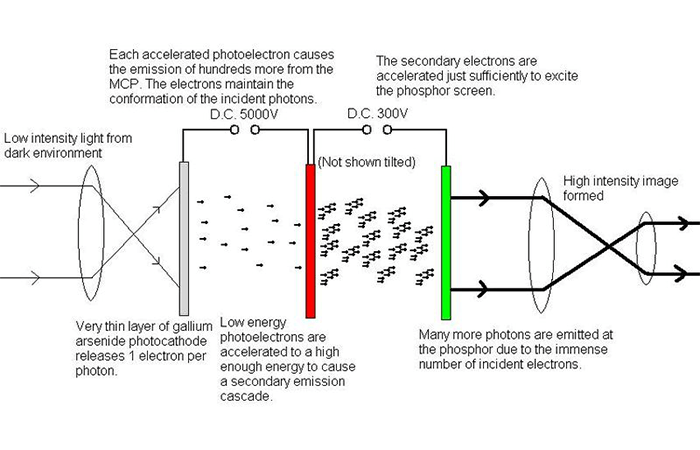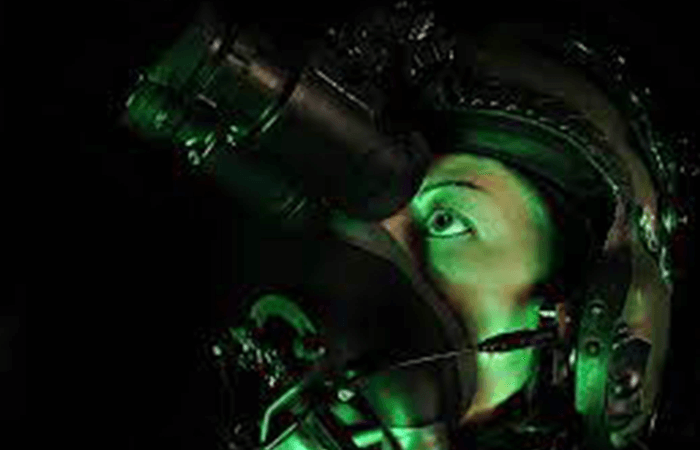Unlike many animals, humans don’t have good night vision due to the lack of tapetum lucidum. Sure, you can see in low light conditions, but you can see very little. Nocturnal creatures such as owls and wolves have excellent night vision, enabling them to hunt even better after dawn.
Night vision does not work in total darkness; it requires some form of visible light to function. A thermal night vision device allows you to work in total darkness using your body’s heat energy. Most people use green light to help them hunt in the dark or a low-powered infrared LED NV device.
The rest of this article will discuss NV and how it works in the dark. We’ll also cover what night vision devices you should use if you have to work in total darkness. Let’s dive in.
What is Night Vision and How It Works?

Night vision is the ability to see things in the dark. Many animals have tapetum lucidum, a mirror-like layer of tissue in the back of their eyes that allows them to see under low light.
When light penetrates the retina, it is reflected by the tapetum lucidum, allowing the animal another chance to sense the light.
You might have seen cats’ eyes shine when you take a photo of them or when your car light flashes at them. The shine you see on their eyes is the pigment on their retina’s inner layer.
Despite having better night vision than us, nocturnal animals’ night vision is not perfect and cannot perform at its best in lightless conditions.
Since we lack tapetum lucidum, our night vision is poor. Unlike us, nocturnal animals have unique rods that enhance their vision in low light.
Since we cannot see clearly in the dark with our naked eyes, we compensate for that with our NV technologies: NV goggles, image intensification, active illumination, and thermal imaging.
Related reading: Can You Aim Using Night Vision Goggles
Can We See in Total Darkness?

We cannot see in total darkness, but we can use specific devices to help us see in the dark or complete darkness.
To see in the dark, one can use digital night vision, night illuminators, or hybrid thermal/night vision. Let’s explore every one of them.
Different Types of Night Vision Devices
Currently, there is a night vision technology that allows seeing in the dark. This technology even allows us to see things in the dark in full color.
If you’re going hunting at night, you can spot your target better and become more aware of your surroundings.
Digital Night Vision
Using charge-coupled devices (CCD) or complementary metal-oxide semiconductors (SMOS) sensitive to infrared, it uses the same technology as the digital camera.
This devices are excellent because they are not very expensive and are pretty sturdy and damage-resistant.
Infrared Illuminators
Digital night vision devices rely heavily on starlight and moonlight to create an image; they will not work well without these natural sources, especially on cloudy days or in total darkness.
Therefore, an infrared illuminator is necessary to enable you to see in total darkness. The illuminator is either a built-in feature in the NVD or can be mounted on the night vision device.
Thermal Imaging
For more advanced night vision performance, you may want to look at thermal imaging. Thermal imaging is the best NV technology.
What makes this tech unique is it does not rely on short-wave infrared light (SWIR) but uses long-wave infrared light (LWIR).
In other words, thermal imaging detects an object using the heat that it lets out. The more heat the object emits, the more long-wave infrared light heat the device can detect.
Thermal imaging uses its bolometers, detectors that identify the thing and its background’s temperature differences to show the user what it is detecting.
You can see the data that the thermal imaging detects on the device’s display screen, which can be in LCD, OLED, or AMOLED. There’s no need for natural light sources or IR illuminators to use the device in total darkness.
You can see whatever is ahead of you as long as there are heat signals emitted by the objects around you, like humans and animals — even in dusty or smoky conditions.
Hybrid Thermal/Night Vision
The Hybrid Thermal/Night Vision is a combination between NVDs and thermal imaging. This technology allows people to enjoy the advantages of both the image intensifier and thermal imaging via only a device.
You can find a variety of gadgets that use this technology, such as binoculars and cameras.
Related reading: Night Vision vs. Thermal Scope
Final Thoughts: Does Night Vision Work in Total Darkness?
We can’t see well in the dark, let alone in total darkness. Nocturnal animals, however, have better night vision thanks to a tissue layer known as tapetum lucidum.
Even though animals (like cats) have excellent night vision, it is useless if light sources are absent.
We may not have good night vision, but we can use night vision technologies to help us see low light, even in total darkness.
Night vision devices, infrared illuminators, and hybrid thermal/night vision help us see low light. You’ll need thermal imaging to see in complete darkness.
Related Articles:
- Gen 2 vs. Gen 3 Night Vision
- Red Dot vs Holographic vs Reflex Sights
- How Does an Illuminated Reticle Work
- Vortex Viper vs Razor Spotting Scope
- How Far Can Night Vision Binoculars See

